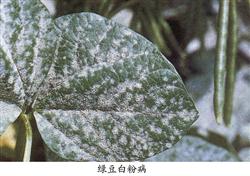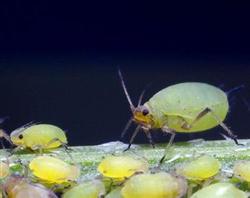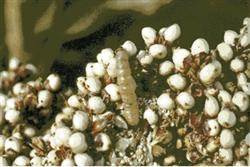What is mung bean powdery mildew?

What is mung bean powdery mildew? Please introduce the symptoms of mung bean powdery mildew: small white powdery spots scattered on the surface of the leaves. When the climate is suitable, the spots expand rapidly, and the diseased leaves are covered with powdery matter, that is, pathogenic hyphae, conidiophores and conidia. After the young pod was damaged, it was deformed and the surface was powdery. In the later stage of the development of the disease, there are small black spots in the white powder, that is, the closed capsule of the pathogen. The incidence rule of mung bean powdery mildew: the pathogen overwintered on the stump of the diseased plant with closed cysts, released ascospores in the second year, spread by wind and rain, and carried out primary infection. Conidia are produced on the disease spot, which are also transmitted by the wind and re-infected. High temperature drying is beneficial to the occurrence of diseases. The prevention and control methods of mung bean powdery mildew are as follows: one is to remove the remains of the diseased plant, and the other is to spray with 2000 times of 15% fenrucine wettable powder or 20% fenruccinin EC at the initial stage of the disease. Click to get more mung bean planting technology click to get more food crop planting technology
- Prev

How to control aphids by planting mung beans?
How to control aphids by planting mung beans? What kind of medicine can be used to control aphids? please introduce the commonly used drugs for planting mung beans to control aphids. There are 2000 to 3000 times of 50% aphid mist wettable powder or water dispersible granule, which has special effect on vegetable aphid and does not hurt natural enemies, or 50% malathion EC, or 20% diazine agricultural EC, or 25% quine.
- Next

How to control sorghum ear grain borer?
How to control sorghum ear grain borer? Please introduce the method of sorghum spike grain borer which mainly harms sorghum spikelets and grains. The harm of loose panicle type was less than that of tight panicle type. Adults lay eggs in the ear, and after hatching, the larvae feed on the grains in the process of grain filling, resulting in a large number of grain losses. The weather of high temperature and humidity is very harmful.
Related
- The first cup of black tea in spring, the flavor and history of tea gardens in Kenya, Africa
- The computer can not only choose potatoes, but also grow tea rice. AI will grow winter oolong tea champion.
- It is not only the inflated tea bitten by insects, but also engraved with the four seasons tea in Beipu.
- The Oriental Beauty Tea Festival in Zhuxian County takes the stage at the weekend to experience the plus-size feast of oil tea.
- & quot; Oriental Beauty Tea & Exploration of Emei in Hsinchu, the hometown of quot;
- The new variety of strawberry "Tainong 1" dessert is the first choice with mellow aroma. Crimson gorgeous
- History of Tea in Taiwan: from Wild Inner Mountain to Export Tea Garden
- Two types of Taiwan Oriental Beauty Black Tea won the British three-Star Award for Childhood Tea Xiang Zhang Jiaqi changed from pilot to champion tea maker.
- Banana species and varieties: the planting history of Taiwan Xianren banana and dwarf banana is long, is banana disease resistant?
- Coffee planting Technology: Qianjie Coffee from Seedling to harvesting

